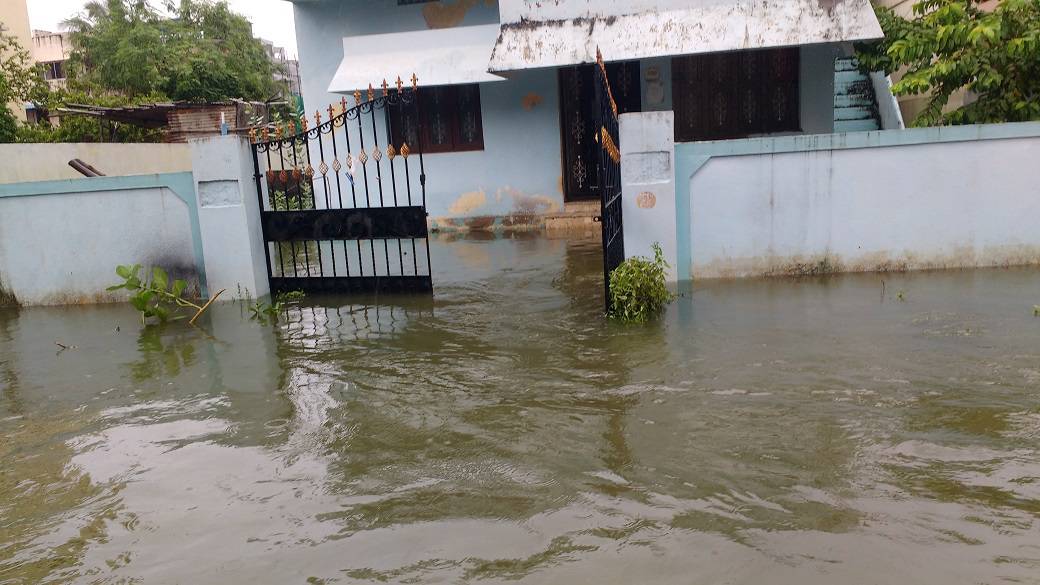The northeast monsoon is here and residents of southern Chitlapakkam have already become victims of yet another flood. Chitlapakkam has seen it all—drought and floods, but this time, the floods have hit residents earlier than they expected. The northeast monsoon has just set in, and residents are left in the lurch, amidst miserable memories of the 2015 floods.
As I enquire about the route to Babu Street, a shopkeeper jokingly says, “Walk straight and take a left, you will see water all over the street. That’s the one!”
Babu Street, Abraham Lincoln Street, Pamban Swamigal Street, Chokkanadhar Street, Maraimalai Adigal Street, Balaji Avenue, Shanthi Avenue, Nazeeb Avenue and Ramakrishnapuram are a few of the major roads in the area that have been flooded. The affected places constitute around 40% of southern Chitlapakkam.
“It was around 01:00 a.m. when water entered my 300 sq. ft house, everyone at home was sound asleep. Most of my neighbours started shifting to the first floor, but I couldn’t. So we all sat crouched on a small stool until the waters receded. We faced the brunt of floods in 2015, nothing has changed except the year,” rues Selvi, a resident of Ramakrishnapuram who works as a dishwasher to make both ends meet.
Because of the continuous rains, water from the Selaiyur Lake overflowed and entered the residential areas of Chitlapakkam. Another reason for the overflow is the release of sewage water into the lakes here. The absence of proper water channels leading to Sembakkam Lake has resulted in inundation.
“The height of the roads is another major cause for the disaster and has added to the water overflow issue. The height is increased every single time the roads are re-laid. Instead of scraping off the roads, the new roads are laid over the old roads, which naturally has resulted in the level of the houses being much lower than the roads,” explains Bala Chandar, a volunteer of the group Chitlapakkam Rising.
If you go around Chitlapakkam, you can spot culverts in most of the streets. Experts also tell you that the very purpose of the construction of culverts has been defeated. Culverts are structures that are built for the water to flow under the roads. In the case of Chitlapakkam, culverts are designed like a bridge with no space given for the water to flow, thus resulting in water stagnation in the streets.
Who will take responsibility?
With no councillor and special officer in place, Chitlapakkam is awaiting substantial change. “We do not have special officers taking charge of our neighbourhood, an Executive Officer (EO) has taken charge. Since the former EO is on medical leave, Vimal Raj, the EO of Perungalathur has been appointed to look after the Chitlapakkam Town Panchayat temporarily. Talks are on for appointing a permanent EO for our Panchayat,” says Bala Chandar.
When asked about the precautionary steps taken to prevent flooding, Kamal Raj, former EO of the Town Panchayat said, “I was temporarily appointed, just before the onset of the monsoon, but I made it a point to de-silt the storm water drains in the area.” However citizens claim that no proper measures had been taken for preventing yet another flood.
“To prevent further calamities from happening, we have kept JCBs and generators for water supply in place and we have gathered sufficient manpower to aid the people,” says present EO Venkatesan on the emergency plan for the area.
Meanwhile, Amudha, an IAS Officer, has inspected the three lakes — Selaiyur, Chitlapakkam and Sembakkam and has planned to submit a proposal for clearing the encroachments along the lake. But it may yet again be a case of too little, too late.
